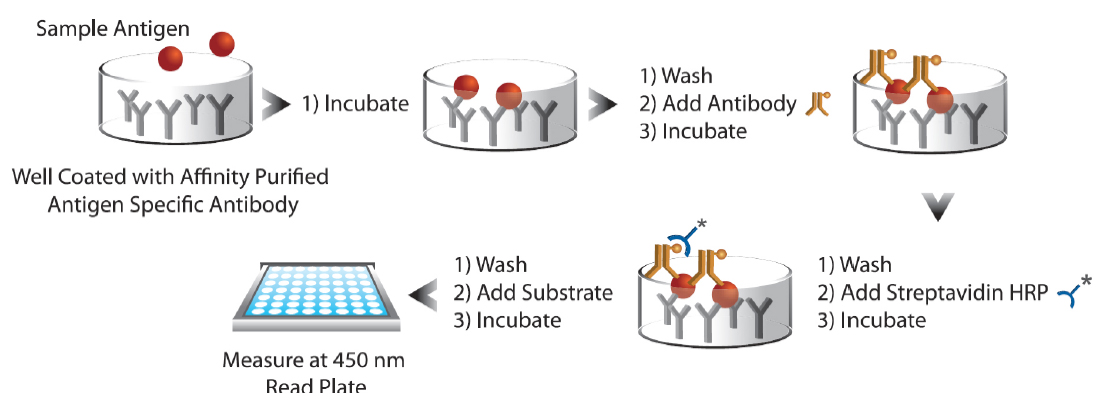The Basics of ELISA Immunoassays
The Basics of ELISA Immunoassays
Featured TechNote
What are the differences between ELISA assay types?Immunometric / Sandwich ELISA Kit

Immunometric assays, also known as sandwich ELISAs (enzyme-linked immunosorbent assay), use two antibodies specific to the antigen to capture or "sandwich” antigen in the well for detection. Immunometric assays exhibit a direct correlation between antigen concentration and substrate response. Immunometric assays typically employ a "capture” antibody coated on the plate to bind the antigen of interest. During a second incubation, the antigen is bound by a second "detection” antibody that is also specific to the antigen. The detection antibody can either be bound by a secondary antibody-enzyme conjugate, or the detection antibody itself is enzyme-conjugated. When chromogenic substrate is added to the assay to develop color, samples with high antigen concentration generate more signal than those with low antigen concentration, producing a signal directly proportional to the amount of antigen in the sample. This correlation can then be used to extrapolate the concentration of antigen in an unknown sample from a standard curve.
- Sample is added to well coated with capture antibody and incubated
- Wells are washed to remove unbound molecules
- Add detection antibody and incubate to bind to antigen creating a “sandwich”
- Wash away excess detection antibody
- Add secondary antibody-enzyme conjugate and wash. Conjugated enzyme is typically horseradish peroxidase (HRP) or alkaline phosphatase (AP)
Note: This step may be omitted if the reporting enzyme is directly conjugated to the detection antibody - Add substrate and incubate to develop signal
- Measure signal in plate reader
Competitive ELISA kit

In competitive enzyme immunoassays (EIA) the antigen in a sample competes for limited antibody binding sites with antigen conjugated to a reporter enzyme. This produces an inverse relationship between antigen concentration and substrate turnover. Competitive EIAs typically use a single antibody to a small molecular weight antigen, generally less than 10,000 Daltons. During incubation, samples with high antigen content result in unlabeled antigen being bound in greater amounts than conjugated antigen. When chromogenic substrate is added to the assay to develop color, samples with high antigen concentration generate a lower signal than those containing low antigen concentration, yielding the inverse correlation between antigen concentration in the sample and color development in the assay. This relationship can then be used to extrapolate antigen concentration in an unknown sample from a standard curve. This type of reaction is one of the few methods possible for small molecular weight antigens, such as steroids, drugs, lipids and peptides.
Recent Posts
-
CRISPR/Cas9 Gene Editing Kits: Unlocking the Genome
Gene Editing Kits for CRISPR/Cas9: An Effective Research and Medical ToolWith the advent of potent g …25th Mar 2024 -
Workstations and equippement
AGTC offers extra discount on new lab installationsThrough our Partnets, Biodas, Gentaur, Genprice a …9th May 2022 -
AGTC Product range
Ask a quotation for bulk reagentsAGTC has the best rates for UK and export for the following instrum …14th Apr 2022


